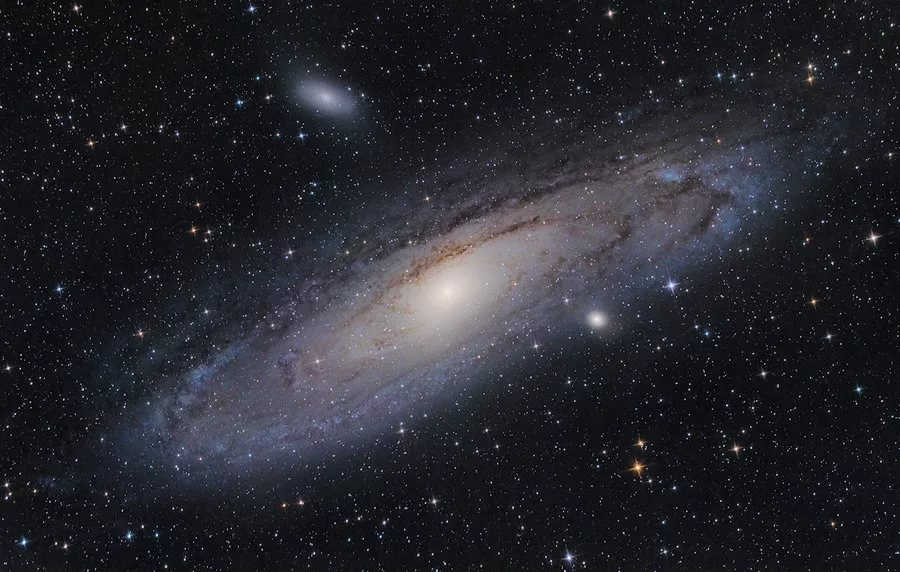Unfortunately, there is an issue with Admiror Gallery that prevents it from generating thumbnails for the Andromeda Nebula images. The error message indicates that there might be a problem with folder permissions. The current version of Admiror Gallery is 4.5.0, and it is running on a server with the operating system Apache/2.4.53 (Red Hat Enterprise Linux 8) and PHP/5.4.45. On the client side, the operating system is Linux, and the PHP version is 5.4.45.
We apologize for any inconvenience caused. Please ensure that the necessary folder permissions are correctly set to resolve this issue with Admiror Gallery. Thank you for your understanding.

The Andromeda Nebula is the most prominent and easily observable galaxy in the Northern Hemisphere.
Situated in the Andromeda constellation, near the Pegasus constellation, the galaxy was initially captured in a photograph in 1887 by British astronomer Issac Roberts. Initially, it was considered a nebula and was given its name based on this classification. However, in 1924, astronomer Edwin Hubble revealed that the Andromeda Nebula is, in fact, a galaxy.
As the closest large galaxy to us, the Andromeda Galaxy is heading towards our own galaxy at a speed of 300 km/sec. This implies that a merger between our galaxy and the Andromeda Nebula is inevitable, projected to occur in approximately 5-7 billion years based on preliminary estimates.
Characteristics of the Andromeda Nebula Galaxy
| Tilt of the galaxy plane: | 15 degrees |
| Visible angular size: | 191′ |
| Visible brightness: | 4,3m |
| Diameter: | 260,000 light-years. |
| Distance to galaxy: | 23,837,859 trillion trillion kilometers or 2,520,000 light years. |
According to scientists, the Andromeda Nebula is a spiral galaxy that contains a colossal black hole at its core, weighing 140 million times the mass of our Sun.
Observing the Andromeda Nebula Galaxy
The Andromeda Nebula galaxy is easily observable through almost any telescope. It possesses a substantial angular size of 191' and a brightness rating of 4.3m' (a remarkably high value for galaxies). The galaxy’s 15-degree inclination allows for a clear view of its disk and nucleus. Moreover, it is a significantly large galaxy, measuring over twice the size of our Milky Way galaxy (which spans 100,000 light years). As the light from this galaxy has traveled to Earth for a staggering 2.52 million years, observing it offers a glimpse into its distant past.
The optimal time to observe this galaxy is during the autumn months when it is closest to the zenith. By August, it is already quite visible in the night sky, even without the aid of a telescope.
Locating the Andromeda Nebula Galaxy is a relatively simple task:
- First, locate the constellation Pegasus in the night sky. Pegasus is situated across the Milky Way from the bright star Vega, which is easily recognizable in the northern sky. Pegasus appears as a quadrangle shape formed by four prominent stars.
- From the upper left corner of the quadrangle, identify a straight line formed by three stars: Mirach, Almach, and Andromeda Delta.
- Continuing from the second star in this line, Mirach, you will notice a branch consisting of several faint stars.
- This branch will lead you to the Andromeda Nebula Galaxy.
It is important to note that the objects depicted in the diagrams are actually larger in size than they appear, due to the nature of star map projections. To provide a visual reference, we have included the actual location of the Andromeda Nebula on a real starry sky:
The Andromeda Nebula Galaxy observed through telescopes of varying aperture sizes
In order to capture these images, photographic equipment was attached to the telescope and photographs were taken using long exposure times.
Summer and autumn offer the optimal conditions for observing the Andromeda Galaxy, also known as the Andromeda Nebula or Messier catalog number M31. It is particularly visible in late August and September, during moonless nights with minimal light pollution. During this time, it appears prominently above the horizon and can be easily identified as a hazy cloud in the sky. Interestingly, some individuals mistake it for a small cloud.
Guide on locating the Andromeda Galaxy in the night sky
The Andromeda Galaxy, also known as the Andromeda Nebula, can be found in the constellation Andromeda, from which it derives its name. Another celestial object that can be spotted with the naked eye in close proximity to the Andromeda Galaxy is the Triangle Galaxy, scientifically designated as M33. However, due to its relatively dim appearance, only individuals with exceptional visual acuity are able to locate it in the sky, as its brightness measures +5.7m, nearly reaching the threshold of human perception. Even when observing through binoculars, the Triangle Galaxy still appears faint.
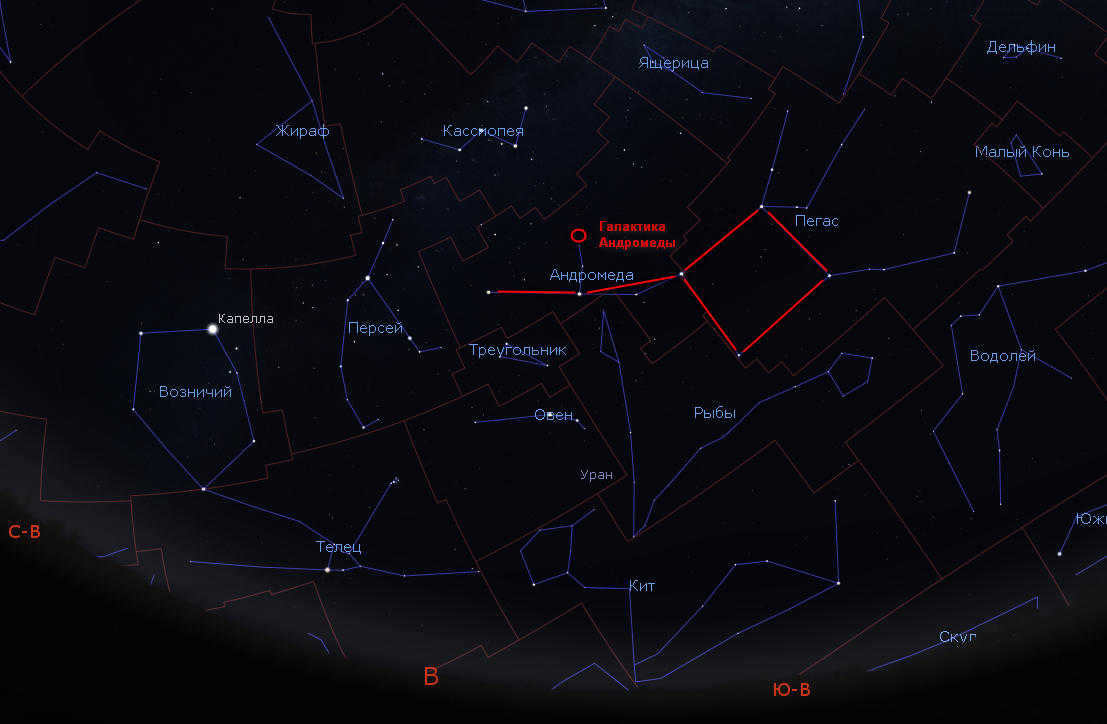
Observing the sky in late August to September, one can easily locate the Andromeda Galaxy and the constellation Pegasus.
The easiest way to find M31 is by locating the constellation Pegasus. The square formation of Pegasus is clearly visible in the southeastern or southern part of the sky. From the upper left corner of the square, there is a line of three relatively bright stars, which represents the constellation Andromeda. By focusing just above the middle star in this line, a cloudy object can be observed – this is the desired target.
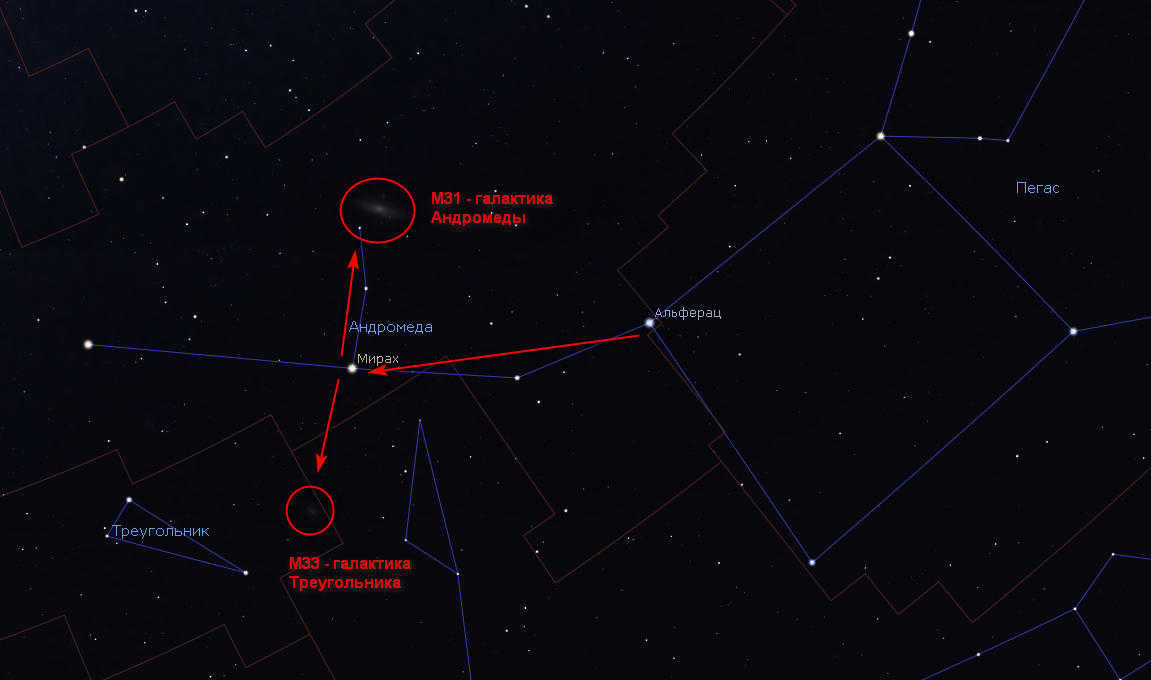
Discovering the Andromeda Galaxy through the guidance of the Pegasus constellation is a fascinating endeavor.
Alternatively, one can take a different approach. In the eastern region of the celestial sphere, positioned high above the horizon, lies the renowned Cassiopeia constellation. Its distinct shape resembles a colossal letter W, making it effortlessly recognizable even to beginners.
Although there is no direct line connecting the stars within the Cassiopeia constellation to the M31 galaxy, the top-right corner of the W formation provides a reasonably accurate indication. This visual cue proves valuable when embarking on the quest to locate the galaxy, as depicted in the diagram below.
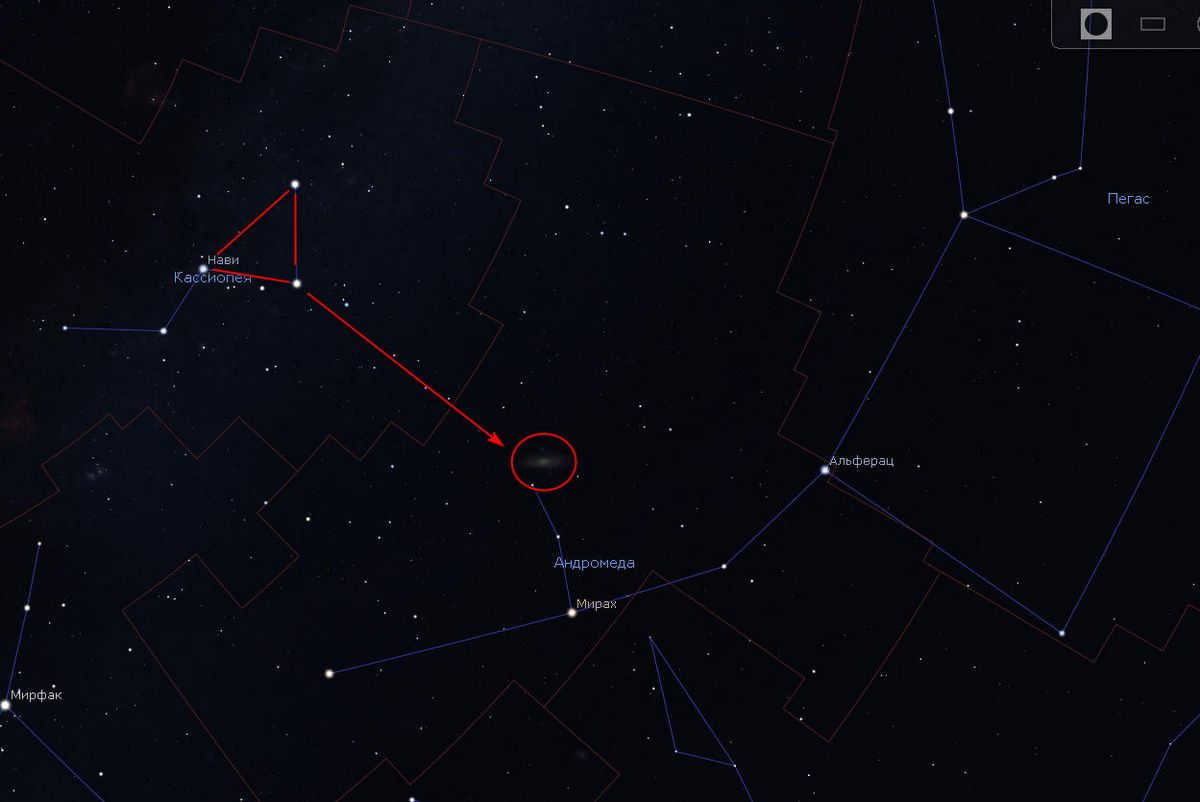
How to locate the Andromeda galaxy by using the constellation Cassiopeia.
What is the Andromeda Galaxy
When you come across this hazy cluster, keep in mind that it is an immense structure with a trillion stars. The Andromeda Nebula is 2.6 times larger than our Milky Way. It takes 260,000 years for a ray of light to traverse it.
You are able to observe it due to its size and its proximity compared to others. However, proximity is a relative concept as the distance to M31 is vast. It takes 2.5 million years for a ray of light to reach us. Therefore, what you are currently witnessing is the light emitted by a trillion stars that departed from this radiant island 2.5 million years ago, during a time when our early human ancestors were just beginning to walk upright.
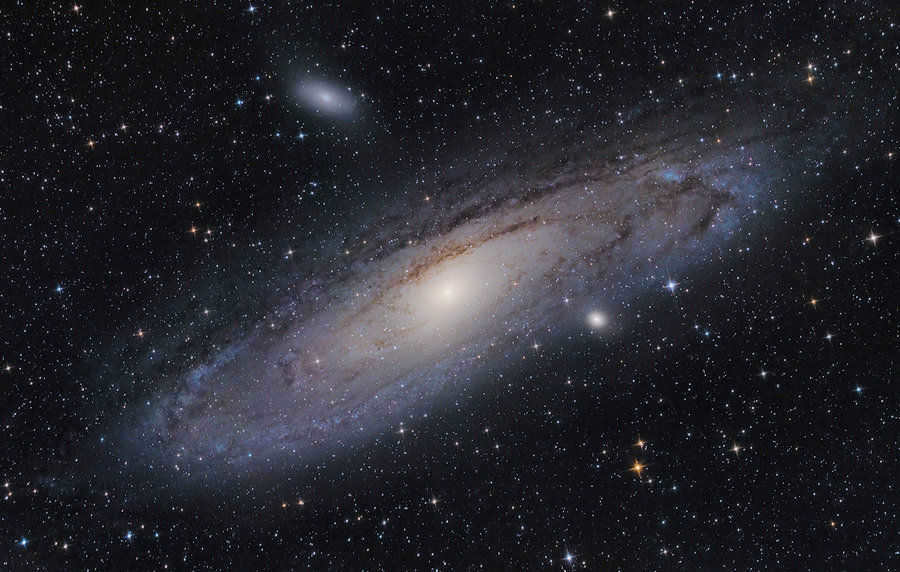
M31 is similar to our Milky Way as it is also a spiral galaxy. However, due to its angle of about 15 degrees, we observe it as an elongated ellipse rather than a flat disk. Despite its beautiful spirals, our perspective limits our ability to fully appreciate them.
Interestingly, the Andromeda Nebula takes up an area in the sky that is seven times larger than the Moon’s disk. However, we can only observe its brightest central part and the light emitted by its spirals. When using 10x binoculars, the vast size of the galaxy becomes apparent as it almost fills the entire field of view. By utilizing side vision, one can also observe that its edges extend far beyond what is initially visible.
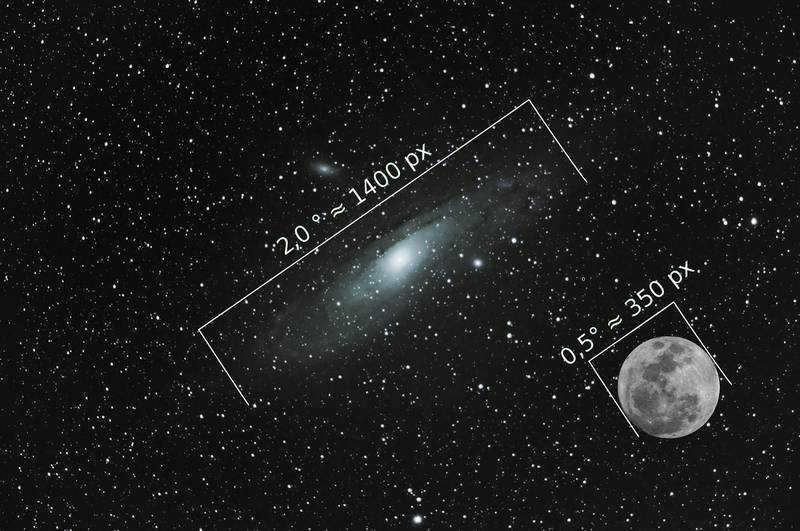
The nebula belongs to which type of galaxy? Andromeda galaxy and the Moon occupy a portion of the sky. Indeed, the galaxy is larger!
This expansive celestial island is approaching us, narrowing the gap at a rate of 300 kilometers per second. In approximately 5 billion years, it will intersect with our Milky Way. This event will mark the beginning of a galactic catastrophe, as the two colossal systems will nearly collide. Countless stars will collide and their trajectories will be disrupted. Some planetary systems will collapse, while new ones will form elsewhere. Stars will be dispersed in certain regions, with some even being ejected from their systems, while new multiple star systems will emerge in other areas.
After the merger of the Milky Way and the Andromeda Nebula, our galaxy will undergo a profound transformation. A new colossal system will emerge, which, over the course of billions of years, will evolve and assimilate nearby galaxies. However, there is no need for concern about this distant future. In approximately 5 billion years, the Sun will expand into a massive red star, rendering the Earth a desolate and barren planet. If humanity perseveres as a species, it will be necessary to seek refuge on other celestial bodies in order to ensure survival.
Why are galaxies visible in our sky while nearby planets are not?

While we have the ability to observe high-resolution images of galaxies that are thousands of light years away, we are unable to see the planets within these distant galaxies. The reason for this is that the distant galaxies are significantly larger and brighter than the planets themselves!
As you may already know, a galaxy is a massive collection of stars, planets, dust, and gas, often numbering in the billions. Our home planet, Earth, resides within a solar system that is part of the Milky Way galaxy. Just like our own galaxy, there are countless other galaxies scattered throughout the universe.
One example of a neighboring galaxy is the Andromeda Galaxy, which happens to be the closest galaxy to our own. Despite being an astounding 2.5 million light years away, this galaxy is so immense that it can still be seen with the naked eye, making it the farthest object visible without the aid of telescopes or other instruments.
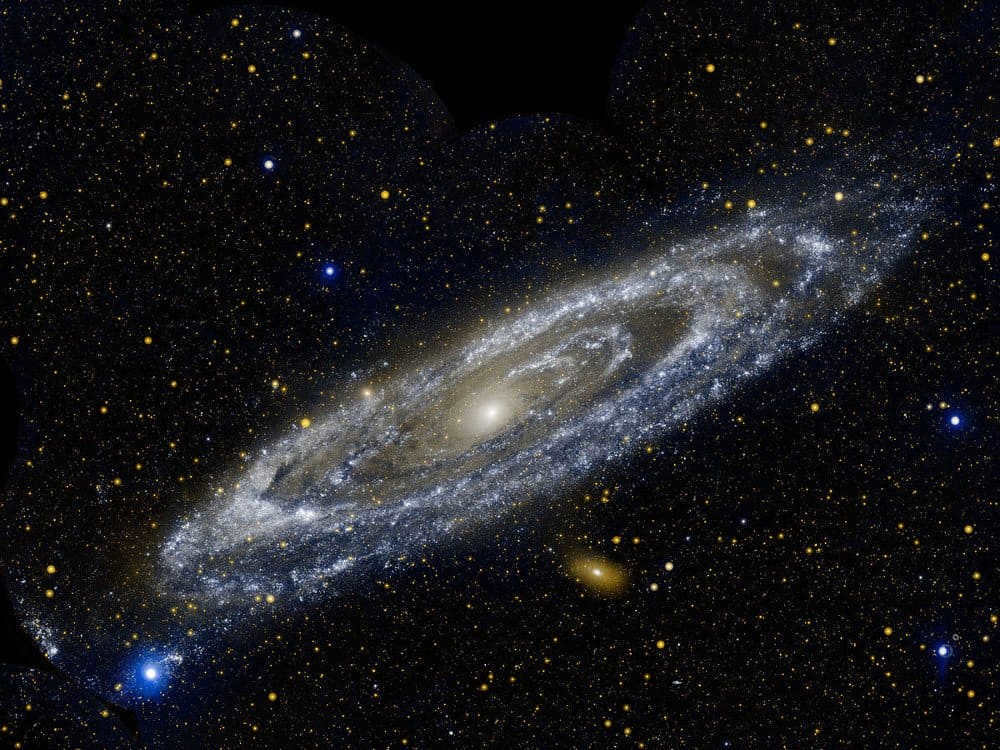
The Andromeda Galaxy is visible to the naked eye and is the most remote object we can observe.
It should be noted that Andromeda is not the nearest galaxy to us. In fact, there are several smaller galaxies that are much closer to us than the Andromeda galaxy. However, the Andromeda galaxy is the closest large spiral galaxy.
Take a moment to consider this – Andromeda is located 2.5 million light-years away from us. For those who are unfamiliar, a light year is the distance that light can travel in one year. And we all know how fast light is – 300,000,000,000 meters per second! This can give you a rough idea of just how incredibly distant the Andromeda galaxy truly is.
Despite its immense distance, we can still observe it in the night sky, as long as we are in the right place at the right time.
It is quite odd that we are unable to observe planets that are just a few light years distant from Earth. In reality, we can hardly detect any planets within our own solar system!
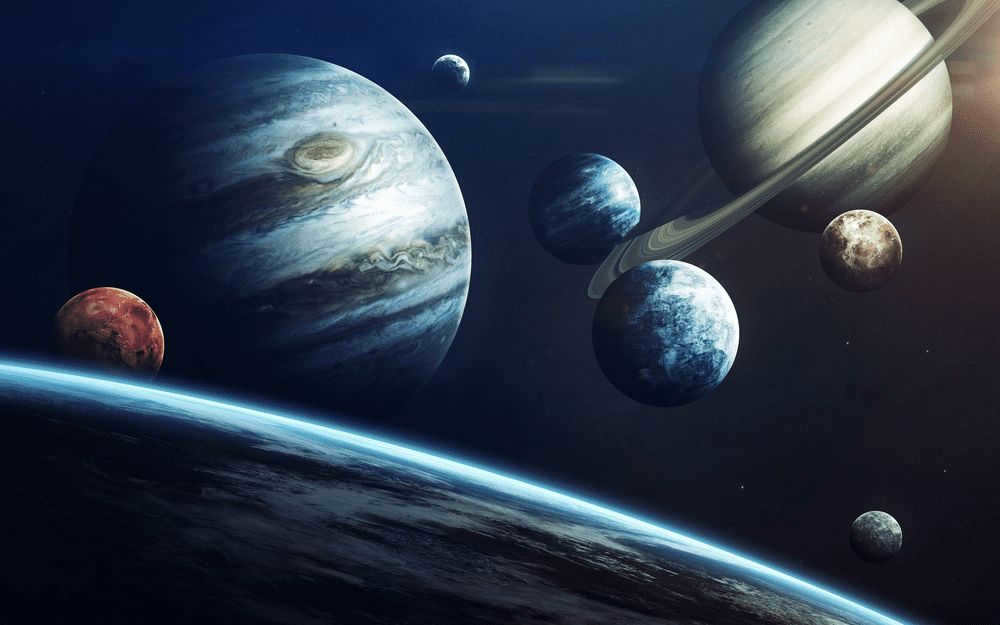
How do we observe distant galaxies?
The observation of distant galaxies is possible due to two main factors:
Despite the vast distances that separate galaxies from our planet and solar system, they possess immense size and mass. Our own galaxy, the Milky Way, is estimated to contain between 100 and 400 billion stars and spans a diameter of approximately 100,000 light years.
In comparison, the Andromeda galaxy is even larger, measuring a width of 220,000 light years!
The closest galaxy to Earth is a dwarf galaxy located in the constellation Canis Major, situated approximately 25,000 light years away from the Sun (equivalent to nearly 236,000,000,000,000,000,000,000,000,000,000,000,000,000,000,000,000 kilometers!). Following that is a dwarf elliptical galaxy in the constellation Sagittarius, positioned at a distance of 70,000 light years (equivalent to 662,000,000,000,000,000,000,000 kilometers!) from the Sun.
Galaxies are not only massive, but they also emit an immense amount of light because of the countless stars they house. This is the reason why they appear so luminous and dazzling, aiding us in their observation during the night.
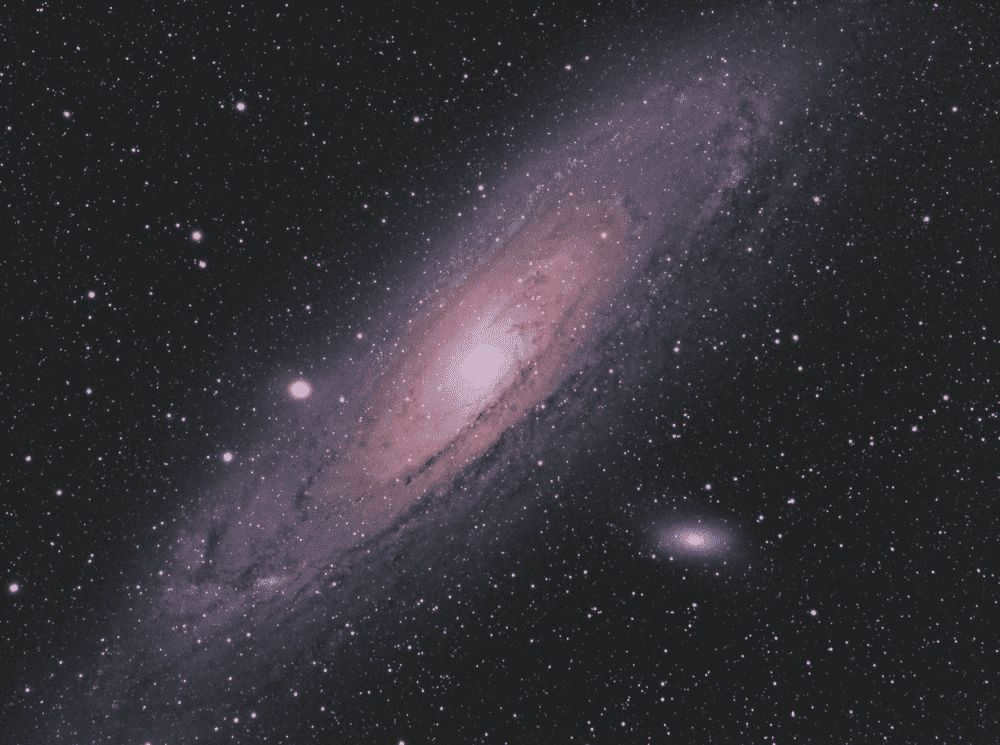
The Andromeda Nebula is an astronomical object that can be observed with the naked eye, but only under very dark conditions.
Why are planets not visible like distant galaxies?
When discussing planets and galaxies, we often fail to consider the vast difference in size between them.
If a galaxy were the size of a basketball, a planet would be a million times smaller, comparable to a minuscule speck of dust stuck to the basketball; in reality, it would be even smaller.
We are unable to visually observe planets located outside of our solar system within a few light-years due to their small size. Additionally, these planets are not easily visible as they only reflect the limited amount of light that reaches their surfaces, which is too faint to be seen from Earth. Therefore, the inability to see planets beyond our solar system is primarily due to their size and dimness.
To illustrate this, consider the following analogy: while it is possible to see a hill that is 10-15 kilometers away from your house, it is highly unlikely that you would be able to see a single grain of sugar that is only a few meters away from your eyes.
In a similar manner, distant galaxies can be observed with the naked eye, but the nearest planets are not visible at all due to their minuscule size and low level of brightness, making them undetectable from Earth.
Deep-Sky Navigation Lessons – Triangle Constellation (Tri)
If the sky in your area is not too bright, you can easily locate the Triangle constellation. It consists of one star with a magnitude of 3m and two stars with a magnitude of 4m. To find it, look just below the main stars of Andromeda, specifically between Beta Andromeda and Gamma Andromeda, along the line connecting them.
South of the Triangle constellation, you will find the slightly brighter zodiacal constellation Aries.
Today, we will explore some of the most fascinating objects in the Triangle constellation, as well as the adjacent areas of the Andromeda and Pisces constellations.
One of the most well-known deep-sky objects in this constellation is the galaxy of the local group, also known as Messier 33 or simply M33.
It is situated at a distance comparable to that of the Andromeda Nebula (M31), but with a much lower brightness due to its status as a medium-sized spiral system, unlike the massive M31. The Triangle Nebula, the Andromeda Nebula, and our Milky Way are the three primary galaxies in the Local Group, meaning they are the largest. Other groups, which we will discuss later, contain large elliptical galaxies. However, we must not forget another significant galaxy in the Local Group, which is similar in size to M33. This galaxy is a satellite of our own Milky Way and is known as the Large Magellanic Cloud. Situated in the southern circumpolar constellations, it is not visible from our latitudes. The other neighboring galaxies are considerably smaller, such as the Small Magellanic Cloud, the satellites of the Andromeda Nebula M32 and M110, the dimmer satellites NGC147 and NGC185 discussed in the previous lesson, and a relatively faint dwarf galaxy in Cassiopeia known as IC10, which is somewhat independent of gravitational forces.
Today, we won’t be discussing other dwarf galaxies that are similar to and less bright than the ones in the Local Group.
Even though the galaxy M33 is close by and relatively large, it is still not as luminous as M31 and can be harder to spot. In a sky with any kind of significant light, whether it’s from artificial sources or natural ones like the Moon or late twilight, this galaxy cannot be seen with the naked eye. Only experienced observers in very dark skies, far away from cities and large villages, can catch a glimpse of it. However, it becomes much more visible when using small binoculars or a telescope. It’s worth mentioning that M33 has a low surface brightness, so it’s extremely challenging to see it in a telescope from a city where the sky is polluted with artificial light.
So, let’s move on from the nearby group of galaxies and delve further into the realm of far-flung stellar systems. Our point of reference will be the star Beta Andromeda, which can be easily spotted even without the aid of a telescope from urban areas. We have previously brought up this star multiple times in our “lessons”: it serves as a guide to locating the Andromeda Nebula in the night sky and also assists in the search for the Triangle Galaxy, also known as M33.
The celestial object known as Mirach is a red giant located 200 light years away from our planet. Its light, which we can observe today, was emitted during the Napoleonic War. When viewed through a telescope, Mirach appears as an orange-yellow hue. If you have a telescope equipped with at least a 100mm refractor or a 130mm reflector, you can easily spot the round elliptical galaxy NGC404, also known as “Mirach’s Ghost,” in close proximity to Mirach. (I personally observed it using a 100mm MAK telescope, and although the galaxy is quite faint, it can be clearly discerned as it possesses a compact structure).
In small telescopes, you can observe a small faint spot illuminated by a bright star: it is located at an angular distance of about 10′ from Mirach, which is equivalent to one-third of the lunar diameter. Naturally, this galaxy is not actually bathed in the rays of Mirach – its distance is 8 million light years. By comparing the brightness and distance, it can be inferred that this galaxy is relatively small, similar in size to M32. However, it is an independent entity and not a companion to any other celestial object. In medium and large amateur telescopes, the view is truly spectacular – a bluish-white sphere softly glows next to a highly luminous, saturated-yellow star. If we were to scale down the Universe to our familiar earthly dimensions, with Mirach taking the place of a lantern in a neighbor’s yard, this galaxy could be likened to a megalopolis on another continent. Of course, this is purely figurative – even in the largest megalopolis, there are far fewer lights than there are stars in a galaxy, even a small one like NGC404.
GROUP OF GALAXIES IN CLOSE PROXIMITY – comprises of numerous galaxies in close proximity to our own galaxy, the Milky Way. The galaxies within the Group move in relation to one another, yet they are held together by the force of gravity and thus have occupied a limited area of approximately 6 million light-years for a significant duration of time, existing independently from other comparable groups of galaxies. There is a consensus that all members of the Group have a shared origin and have been evolving collectively for approximately 13 billion years.
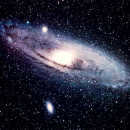
Astronomers are particularly intrigued by the galaxies in the Local Group because they offer a unique opportunity for detailed study. Not only do these galaxies provide valuable insights into the workings of our own Milky Way, but they also exert a noticeable influence on it. The Local Group is just one part of a larger cosmic structure known as the Local Supergroup, which includes neighboring galaxy groups and more densely populated galaxy clusters. Stretching across approximately 100 million light-years in diameter and roughly 35 million light-years in thickness, this flattened system is centered around a massive cluster of galaxies located in the Virgo constellation, some 50 million light-years away from our own position.
Inside the Local Cluster, there is a noticeable pattern in the distribution of small galaxies: many of them are attracted to the larger galaxies, such as the Milky Way and the Andromeda Nebula. These two are often referred to as “parent” galaxies, although the exact genetic relationship between large and small galaxies is not fully understood yet. It is possible that the small star systems act as ancestors to the larger ones. However, the term “parent galaxy” is used metaphorically, as a large star system is surrounded by smaller companion galaxies, resembling a family with children.
For instance, our Milky Way is accompanied by fairly large Magellanic Clouds and several smaller systems – Fornax, Draco, Sculptor, Sextans, Carina, and others. The entourage of the Andromeda Nebula includes the significantly large Messier 32 and NGC 205, as well as the smaller NGC 147, NGC 185, And I, And II, And III, etc. This is not an unusual feature of the Local Group: in the galaxy realm, small satellites often accompany a prominent “leader”. Such groups of approximately 1 million light years in size are commonly known as hypergalaxies. Hence, we can state that the primary constituents of the Local Group are two hypergalaxies – the Milky Way and the Andromeda Nebula.
The spiral galaxy M 33, located in the constellation Triangle, is the third largest and most massive galaxy in the Local Group. While it does not appear to have any satellites, there are some small galaxies in close proximity to M 33 on the sky, closer than they are to the Andromeda Nebula (M 31). However, the Andromeda Nebula is much more massive than M 33, so even its distant satellites are influenced by its gravitational pull rather than that of its less massive neighbor. The Local Group is primarily composed of spiral, irregular, and dwarf galaxies, which is typical for smaller and less dense clusters. Unlike richer clusters, the Local Group does not contain many large elliptical galaxies. The only true elliptical galaxy in the Local Group is M 32, which is a close companion of the Andromeda Nebula. The remaining spheroidal (type Sph) and dwarf spheroidal (dSph) galaxies in the Local Group are not considered true elliptical systems because they are less dense, have a weak concentration towards the center, and contain interstellar gas and young stars.
The Local Group is surrounded by other small clusters of galaxies. One of these clusters, located in the direction of the constellations Pump and Sextant, is approximately 5.5 million light-years away from the center of the Local Group. Another cluster, known as Sculptor, is approximately 8 million light-years away. There is also a group that includes the large spiral galaxy M 81 and the interacting galaxy with intense star formation M 82, which is approximately 11 million light-years away. The Nassos-Sextant group, which includes small galaxies NGC 3109, Pump, Sextant A, and Sextant B, was once thought to be part of the Local Group due to its proximity to us. However, further analysis of their motion has led experts to conclude that this group is actually independent and slowly moving away from the Local Group.
Milky Way Subgroup.
Located within the confines of our Galaxy, encircled by interstellar gas and dust, we currently lack the ability to accurately envision the overall appearance of our stellar system, or even identify all of its neighboring entities, particularly those concealed behind the band of the Milky Way. Thanks to the utilization of infrared telescopes, some of the galactic satellites have been uncovered only recently, as the longer-wavelength radiation emitted by stars is able to traverse interstellar dust with greater ease.
There are some satellites orbiting the Galaxy that can be found within its halo. The Galaxy’s disk has a radius of approximately 40 thousand light years, but the spherical halo extends much further, reaching a distance of about 400 thousand light years. It is within this region that globular clusters, which are typical members of the halo population, are scattered. One of the most notable residents of the halo are the massive Magellanic Clouds. It is believed that in the past, they were located farther away from the center of the Galaxy and were connected as a pair. However, over time, the Magellanic Clouds have been moving closer to the Galaxy’s center, resulting in the loss of their connection with each other and the material from their outer regions. Along their orbit, there is a “tail” of stars and gas that has been left behind, known as the Magellanic Stream.
The Magellanic Clouds contain a significant amount of gas and young stars. Despite being about 10 times smaller in mass compared to our Galaxy, they still hold a similar amount of interstellar matter. The BMO exhibits vast regions of star formation, which are easier to study in comparison to the Milky Way due to its lower dust content. Numerous young star clusters, including those with massive stars, have been discovered in the BMO along with numerous remnants of supernova explosions. The sole supernova event observed within the Local Group during the 20th century occurred in the BMO in 1987.
An unexplained event took place in the BMO approximately 4 billion years ago, resulting in a widespread occurrence of star formation. This event is commemorated through numerous star clusters of the same age. It is possible that the convergence of the Clouds with each other or with the Galaxy may have been the catalyst for this phenomenon. By examining more distant double galaxies, scientists have observed that their mutual approaches often lead to a heightened level of star formation.
The destiny of the Magellanic Clouds appears rather certain: as they complete a few more rotations around the Galaxy and draw closer to its center, they will be subjected to tidal forces and get “stretched” along their orbit. Their stars and star clusters will merge with the Galaxy, but for a considerable period, they will flow together in a broad stream, serving as a reminder of their shared genetic heritage. Numerous streams of this nature have already been identified in the Galaxy’s halo. It is likely that these are remnants of former satellites, similar to the Magellanic Clouds, that have been assimilated in the past.
Regrettably, the orientation of the Andromeda Nebula’s disk relative to our line of sight is nearly perpendicular: the angle between our line of sight and the disk plane is only 15 °. Consequently, exploring the structure of Andromeda’s spiral arms is not significantly easier than studying the Milky Way’s structure. Conversely, for astronomers observing the Andromeda Nebula, our Galaxy poses its own challenges: they observe our disk at a mere 21 ° angle.
As the largest constituent of the Local Group, the Andromeda Nebula is accompanied by a substantial entourage of satellite galaxies. Alongside these satellites and the spiral galaxy M 33, it forms a subgroup of stellar clusters that span the constellations of Andromeda, Cassiopeia, Triangle, and Pisces. This region has been aptly named the “Andromeda Archipelago” by the renowned astronomer Harlow Shapley.
Similar to how the Magellanic Clouds are in close proximity to our Galaxy, the largest satellites of Andromeda are situated very near its core. However, they differ greatly from the Magellanic Clouds, as they lack gas and young stars. Andromeda’s companions are spheroidal galaxies that have minimal interstellar matter. One standout is the compact and dense elliptical galaxy M 32, which possesses a relatively massive nucleus. It orbits dangerously close to the Andromeda Nebula and is under the strong gravitational influence of it, resulting in the stripping of its outer regions. In a few billion years, this influence will ultimately lead to the satellite’s complete destruction.
NGC 205, an elongated spheroid, is located a bit further away from the spiral “host”. Its shape is influenced by the massive Andromeda, causing its outermost parts to have a noticeable curvature. NGC 205 contains various globular clusters, interstellar gas, and relatively young stars. Two more distant companions of Andromeda, NGC 147 and NGC 185, are also present, although they are smaller in size. It is believed that these two galaxies form a binary system and orbit around the spiral “host” together.
A new discovery was made in 2003 in the Andromeda Nebula, where a new companion (And VIII) was found. This companion was observed in the background of the nebula’s disk, around the area where the galaxy M 32 is located. Due to the strong influence of the host galaxy, this companion is not easily visible in regular photographs as it has been heavily eroded. It has a length of nearly 10 kiloparsecs and is only a few kiloparsecs wide. Its luminosity is approximately 200 million solar luminosities. Additionally, several planetary nebulae and globular clusters have been observed within it, along with about 400 thousand solar masses of neutral hydrogen. These discoveries serve as evidence that the composition of the Local Group of galaxies is not fully understood yet.
The examination of the nearest galaxies to us – members of the Local Group, is extremely beneficial and informative in uncovering the structure and life history of the most typical, most prevalent stellar systems in the Universe.
Vorontsov-Vel’yaminov B.A. Extragalactic astronomy. Moscow, 1978
Klypin A.A., Surdin V.G.. Large-scale structure of the Universe. Moscow, 1981
Sharov A.S. The Andromeda Nebula. Moscow, 1982
Pskovsky Y.P. Neighbors of our galaxy. Moscow, 1983
Gorbatsky V.G. Introduction to the physics of galaxies and galaxy clusters. Moscow, 1986
Sharov A.S. Messier spiral galaxy 33. Moscow, 1988
Van den Bergh S. The Galaxies of the Local Group. Cambridge: Cambridge Univ. Press, 2000
Reshetnikov V.P. Surface photometry of galaxies. St. Petersburg, 2003
The Andromeda galaxy, also known as the Andromeda Nebula or Messier catalog number M31, offers the best observation opportunities during the summer and fall seasons. It is particularly visible in late August and September, during dark, moonless nights. At this time, it appears prominently above the horizon and can be easily spotted in the sky as a hazy cloud. Interestingly, some individuals mistake it for a mere small cloud.
The Andromeda Nebula is situated in the Andromeda constellation, which is why it was given this name. Furthermore, the Triangle Galaxy, M33, can be observed nearby without the aid of a telescope. However, it is considerably dimmer and can only be seen by those with exceptional vision, as its magnitude is +5.7m, nearing the threshold of visibility. It appears even fainter when viewed through binoculars.

Observing the sky in late August to early September reveals a captivating sight – the placement of the Andromeda Galaxy and the Pegasus constellation.
The simplest way to locate M31, also known as the Andromeda Galaxy, is through the guidance of the Pegasus constellation. Its distinct square shape can be easily spotted in the southeastern or southern region of the sky. Extending from the upper left corner of the Pegasus square is a series of three rather luminous stars – this is the Andromeda constellation. By directing your gaze just above the middle star in this celestial line-up, you will catch a glimpse of a hazy cloud-like formation – this is precisely our sought-after object.

Guide on locating the Andromeda Galaxy using the Pegasus constellation.
There is an alternative method as well. In the eastern region of the celestial sphere, positioned high above the horizon, the prominent Cassiopeia constellation is clearly visible. Its shape resembles a large letter W, making it effortless for even first-time observers to locate.
Despite the absence of a direct line connecting the stars of Cassiopeia to M31, the right corner of the W figure serves as a reliable pointer. This feature can be utilized to facilitate the search, as depicted in the diagram below.

Discovering the Andromeda galaxy through the constellation Cassiopeia.
Understanding the Andromeda galaxy
Once you locate this hazy formation, bear in mind that it is an immense system housing a trillion stars. The Andromeda Nebula is 2.6 times larger than our own Milky Way. It takes a staggering 260,000 years for a light beam to traverse its expanse.
You can observe it due to its size and its comparatively closer proximity. However, closeness is a subjective term, as the distance to M31 is vast. It takes 2.5 million years for a beam of light to reach us. Thus, what you are currently witnessing is the illumination emitted by a trillion stars that departed this celestial island 2.5 million years ago, when our earliest human ancestors were still mastering the art of bipedalism.

M31, similar to our Milky Way, is a spiral galaxy. However, due to its positioning at an angle of approximately 15 degrees to us, it appears as an elongated ellipse rather than a traditional disk shape. While its spirals should be stunning, unfortunately, we are unable to fully appreciate their beauty from this particular vantage point.
Interestingly, the Andromeda Nebula covers an area in the sky that is seven times larger than the Moon’s disk. However, we are only able to observe its brightest central region and the light emitted from its spirals. When viewing the galaxy through 10x binoculars, one can appreciate its immense size as it nearly fills the entire field of view. Additionally, when using peripheral vision, it becomes apparent that its edges extend far beyond what is initially visible.

The region in the sky occupied by the Andromeda galaxy and the Moon. Indeed, the galaxy is larger!
This immense celestial island is approaching us, reducing the distance by 300 kilometers per second. In approximately 5 billion years, it will intersect with our Milky Way. This event will mark the onset of a galactic catastrophe as two colossal systems nearly collide. Countless billions of stars will collide and their trajectories will be disrupted. In certain regions, planetary systems will collapse while new ones will take shape elsewhere. Some stars will be scattered, with a few even being ejected from their respective systems, while new multiple systems will emerge in other areas.
Our galaxy will undergo a drastic transformation as a result of this event. The merging of the Milky Way and the Andromeda Nebula will generate a colossal new celestial structure, which, over the course of billions of years, will assume a fresh configuration and assimilate other nearby galaxies. However, there is no need for concern – in five billion years, the Sun will have swelled into a massive red star, and the Earth will have become an uninhabitable charred wasteland. If humanity endures as a species until then, it will need to search for alternative stellar abodes in order to ensure its survival.
Unique Content
Galaxies are vast collections of billions of stars, as well as dust and gas, that are bound together by the force of gravity. They can exist either on their own or in groups.
Each galaxy contains anywhere from several hundred thousand to tens of trillions of stars. Additionally, galaxies are filled with interstellar dust and gases. All of these stars orbit around a central point within the galaxy, which is typically a massive star cluster. The distance between neighboring galaxies is usually measured in millions of light years.

What is the count of galaxies in the Universe?
In the past, scientists had a limited view and could only observe a small number of galaxies. However, with the advent of the Hubble Telescope in 1990 and the development of advanced telescopes on Earth, the number of observable galaxies has increased exponentially. Present-day astronomers estimate that there are approximately 100 billion galaxies in the observable portion of the Universe.
Just like celestial objects, galaxies also orbit larger cosmic bodies and have the ability to form clusters. Take, for instance, our very own Milky Way galaxy, which is surrounded by 14 dwarf galaxies, many of which have irregular shapes. Additionally, the Milky Way is part of a larger group that includes neighboring galaxies such as the Andromeda Nebula and the Triangle Galaxy, each with their own satellites. Together, they make up the Local Group of galaxies, which is a component of the Virgo Supergroup.
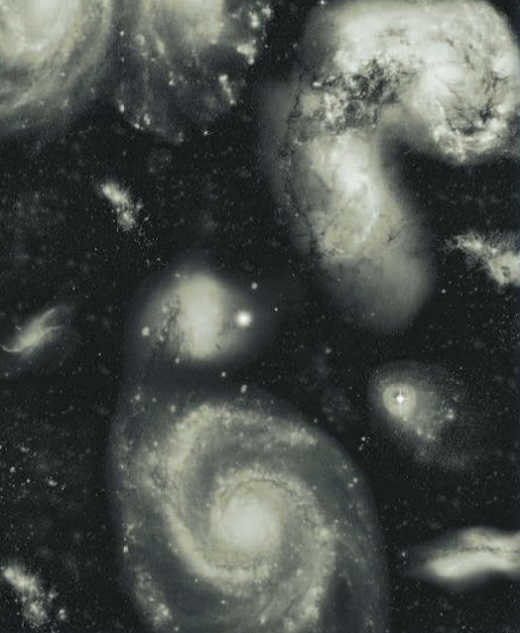
What is the biggest galaxy?
It remains uncertain which galaxy holds the title for being the largest. At present, the largest galaxies that have been discovered are massive elliptical (oval-shaped) galaxies found in the heart of galaxy clusters. Among these, the Central Galaxy, situated within the Abell 2029 cluster, stands out as one of the largest.
What is the reason behind the name of our galaxy, the Milky Way?
When observing the night sky on a clear night, one may notice a hazy white band. In ancient times, the Greeks were reminded of the heavenly path, where the goddess Hera supposedly spilled milk. As a result, the Greeks referred to this band as the milky way, or the milky way. Interestingly, the term “galaxy” itself originates from the Greek word galaxias, meaning “milky.”

The size of the Milky Way is immense. It takes approximately 250 million years for the Sun to complete one orbit around the center of the Milky Way.
A cluster of nearby galaxies
Within the vast expanse of the universe, the Milky Way and its closest neighbors form a cluster known as the Local Group of galaxies. This designation is given because these galaxies are located in close proximity to Earth. Among the members of the Local Group, which consists of about 30 galaxies, only three are visible to the naked eye: Andromeda, the Large Magellanic Cloud, and the Small Magellanic Cloud.

Andromeda Nebula
The Andromeda Nebula is the dominant galaxy in the Local Group, boasting a staggering 18 satellites. It is home to an estimated 1 trillion stars, all gracefully orbiting within its vast expanse. This colossal galaxy is located a mind-boggling distance of 2.5 million light years away from Earth, yet it remains visible to the naked eye. With its captivating spiral shape and an abundance of youthful, luminous stars, the Andromeda Nebula truly stands out. It is worth noting that in ancient times, the entire galaxy was not visible to the naked eye, but only the constellation Andromeda.

The Andromeda Galaxy, also referred to as M31 or Messier object 31, is recognized for its immense size, surpassing that of the Milky Way. However, it is not considered the largest galaxy in existence.
What are the characteristics of galaxies?
Galaxies exhibit a diverse range of shapes and sizes. Scientists classify them into three main categories based on their shape: spiral, elliptical (oval), and irregular (shapeless).
Elliptical galaxies
are a type of galaxy that have an oval or elliptical shape. They are composed primarily of old stars and have little to no gas or dust. Elliptical galaxies are often found in galaxy clusters and are considered to be one of the oldest types of galaxies in the universe. They have a distinct lack of spiral arms and do not have active star formation. Instead, they are dominated by a central bulge of stars. The shape of elliptical galaxies can range from nearly spherical to highly elongated. They are thought to form through mergers of smaller galaxies or through the gravitational collapse of gas clouds. Overall, elliptical galaxies provide valuable insights into the early formation and evolution of the universe.

These galaxies, known as ellipticals, derive their name from their elliptical shape, resembling an irregular circle. While generally rounded, elliptical galaxies are slightly elongated in one direction compared to the other. The majority of galaxies in the cosmos exhibit an elliptical shape.
Spiral galaxies are a common type of galaxy in the universe.

Irregular galaxies are characterized by flat clusters of stars with spiral-like “tails” or arms that extend out from a compact central region. These galaxies are the second most prevalent type found in the universe.
Irregular galaxies

Irregular galaxies do not possess a distinct shape. Scientists theorize that these galaxies form as a result of the collision between two galaxies or when the gravitational force of a nearby galaxy causes a change in the shape of a galaxy.
“Dark” galaxies
Within the vast expanse of the Universe, there exists a multitude of galaxies that contain very few, if any, stars. These galaxies consist primarily of dark matter and are referred to as dark galaxies.

Actually, there might be a multitude of galaxies similar to the typical galaxies with shining stars and glowing gas. Furthermore, luminous galaxies also possess substantial quantities of dark matter, which often outweighs the mass of all the stars in the galaxy by a factor of 10.
The ideal seasons for observing the Andromeda Galaxy, also recognized as the Andromeda Nebula or Messier catalog number M31, are summer and autumn. It becomes particularly visible in late August and September, during moonless nights. At that time, it appears high above the horizon and can be spotted by any individual with good vision as a hazy cloud. Interestingly, some individuals mistake it for a small cloud.
The Andromeda Nebula is situated in the Andromeda constellation, hence its name. Alongside it, one can also spot the nearby Triangle Galaxy, M33, with the naked eye. However, it appears much dimmer and only individuals with exceptional eyesight can detect it in the sky, as its brightness reaches +5.7m, approaching the threshold of visibility. Even when observed through binoculars, it still appears faint.

Observing the night sky in late August or September, one can easily locate the Andromeda Galaxy and the constellation Pegasus.
To find M31, the Andromeda Galaxy, one can start by locating the constellation Pegasus. The square shape of Pegasus can be clearly seen in the southeastern or southern part of the sky. From the upper left corner of the square, there is a line of three rather bright stars, which belongs to the constellation Andromeda. By focusing just above the middle star in this line, one can spot a hazy cloud-like object, which is our target.

Discovering the Andromeda Galaxy using the Pegasus constellation.
Another method can also be employed. In the eastern region of the celestial sphere, positioned high above the horizon, the prominent Cassiopeia constellation can be easily observed. Its configuration resembles a colossal letter W, making it effortless even for beginners to locate.
Although there is no direct line connecting the stars within the Cassiopeia constellation that leads to M31, the right corner of the W formation approximately points towards it with a reasonable level of precision. This can serve as a guide to locate it, as depicted in the diagram below.

Discovering the Andromeda galaxy through the constellation Cassiopeia.
Understanding the Andromeda Galaxy
When locating this hazy formation, keep in mind that it is an immense system housing a trillion stars. The Andromeda Nebula is 2.6 times larger than our own Milky Way. It takes 260,000 years for light to traverse it.
You can observe it due to its size and its close proximity compared to other galaxies. However, closeness is a relative concept, as the distance to M31 is staggering. It takes 2.5 million years for light to travel from there to us. Hence, what you are witnessing is the light emitted by a trillion stars that departed from this celestial island 2.5 million years ago, when our earliest human ancestors were just beginning to stand upright.

M31, also known as the Andromeda Galaxy, is a stunning example of a spiral galaxy much like our own Milky Way. However, due to its orientation at an angle of approximately 15 degrees from our vantage point, we perceive it as an elongated ellipse rather than a typical disk shape. As a result, we are unable to fully appreciate the beauty of its spirals from this particular perspective.
Interestingly, the Andromeda Nebula, which encompasses M31, covers an area in the sky that is seven times larger than the visible disk of the Moon. Unfortunately, we are only able to observe the brightest central region of the nebula and the light emitted by its spirals. Nonetheless, when looking through binoculars with a magnification of 10x, one can observe that the galaxy appears remarkably large, nearly filling the entire field of view. Moreover, utilizing peripheral vision reveals that its edges actually extend much farther than initially perceived.

The nebula belongs to which type of galaxy? That’s right, it’s the Andromeda galaxy!
This vast expanse of stars is rapidly approaching our own Milky Way galaxy, closing the distance between them at a rate of 300 kilometers per second. In approximately 5 billion years, these two colossal systems will collide, resulting in a galactic cataclysm. During this event, hundreds of billions of stars will collide, causing their trajectories to be disrupted. Some planetary systems will collapse while others will form anew. Stars will be scattered in various directions, some may even be ejected from their respective systems, and new multiple star systems will emerge.
Following the merger of the Milky Way and the Andromeda Nebula, our galaxy will undergo a profound transformation. This cosmic event will result in the creation of a colossal celestial entity, which will gradually evolve over billions of years, engulfing neighboring galaxies along the way. However, there is no need for concern as this process will not impact us directly. In approximately 5 billion years, the Sun will expand into a massive red star, rendering the Earth a desolate and uninhabitable wasteland. Should humanity endure as a species until then, we will be compelled to seek refuge on other stellar bodies in order to ensure our survival.
The Triangle Galaxy (M 33, NGC 598) is a unique celestial object.
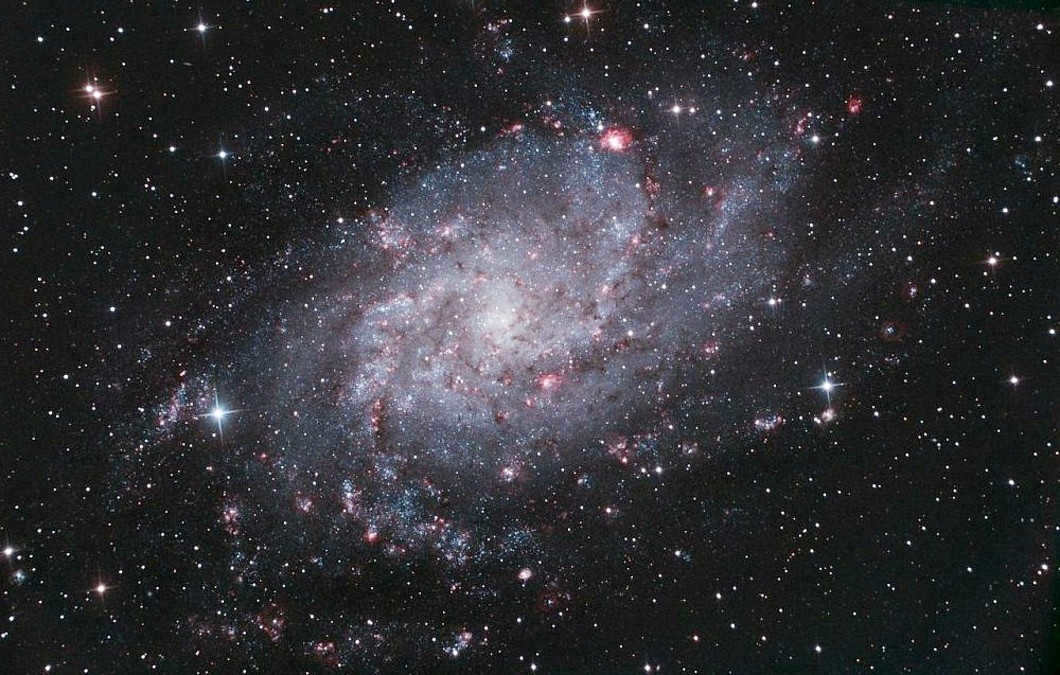
Messier 33, also known as the Triangle Galaxy, is a spiral galaxy located in the Triangle constellation. Its catalog designation is NGC 598. Situated approximately 3 million light-years away from Earth, this galaxy possesses a diameter of approximately 50,000 light-years.
Within the local group, Messier 33 is the third largest galaxy, residing alongside notable celestial bodies such as the Andromeda galaxy (M 31), the Milky Way, and around 44 smaller galaxies. It is estimated that Messier 33 contains 40 billion stars, making it significantly smaller in size compared to the other two prominent galaxies in the local group. The Milky Way is believed to harbor 400 billion stars, while the Andromeda galaxy is home to a staggering trillion stars.
The Triangle galaxy is currently in motion towards Andromeda (M 31). It is possible that these two galaxies had interacted gravitationally in the past, somewhere between 2 to 8 billion years ago.
Andromeda’s gravitational force caused some stars to be pulled out from M 33, resulting in a tail that now stretches between the two galaxies. As a result, some of the stars from the Triangle galaxy now belong to Andromeda. M 33 might be the galaxy that is gravitationally bound to M 31.
The distance between these two galaxies is less than 300 kiloparsecs, and eventually, they will merge together. It is estimated that in approximately 2.5 billion years, the significantly larger Andromeda galaxy will completely engulf the Triangle galaxy. The merger of these two galaxies could potentially occur one or two billion years prior to the collision between Andromeda and our Milky Way galaxy.
Studying the Triangle Galaxy
M 33 is an astronomical object that can be observed without the need for binoculars or a telescope, making it one of the most distant deep-sky phenomena. However, optimal viewing conditions are necessary to see the Triangle Galaxy with the naked eye. Although visible without aid, even a small amount of light pollution can hinder its visibility.
The Triangle Galaxy, also known as Messier 33, is significantly smaller and less massive than our own Milky Way. Its proximity to our galaxy makes it the second brightest galaxy in the sky. It is tilted at an angle of 54 degrees towards us and appears larger than the full Moon.
When observing Messier 33, it is best to use low magnification. Larger telescopes with an aperture greater than 40 cm have the ability to reveal some of the globular star clusters within the galaxy.
Discovery of the Triangle Galaxy
The Triangle Galaxy is said to have been spotted by Italian astronomer Giovanni Battista Godierna prior to 1654. He recorded the entity as a cloud-like nebula or obscuration.
Charles Messier independently discovered the galaxy on August 25-26, 1764, and added it as the 33rd item in his 1771 inventory of nebulae and star clusters. William Herschel, who typically refrained from including more chaotic objects in his personal catalog, made an exception with M 33 and logged it as H V-17 on September 11, 1784.
Distinctive Characteristics of the Triangle Galaxy
The Triangle Galaxy, classified as SA(s)cd, possesses unique attributes that set it apart. It is a disk-shaped galaxy devoid of a bar structure, exhibiting prominent spiral arms that extend directly from its galactic nucleus. The loose coiling of the galaxy’s spiral arms, denoted by the suffix cd, further highlights its distinctiveness.
In contrast to our own Milky Way, the Triangle Galaxy lacks a central bulge composed of stars.
Remarkably, the nucleus of Messier 33, the Triangle Galaxy, showcases a prominent H II region. Notably, it contains an exceptionally bright X-ray source, a rarity within the local group of galaxies. The close proximity of an X-ray source to a galactic nucleus is considered an exceedingly uncommon occurrence.
As for its motion, the Triangle Galaxy is currently approaching our galaxy at a velocity ranging from 179 to 182 km/s. In comparison, our galaxy is moving towards it at a velocity of 24 km/s.
Up to this point, the Triangle Galaxy has not observed any supernovae, although it possesses approximately one hundred remnants of supernovae, with the majority concentrated in its southern hemisphere. On average, an explosion of a supernova takes place every 147 years within M 33. Furthermore, the galaxy serves as the dwelling place for no less than 112 variable stars.
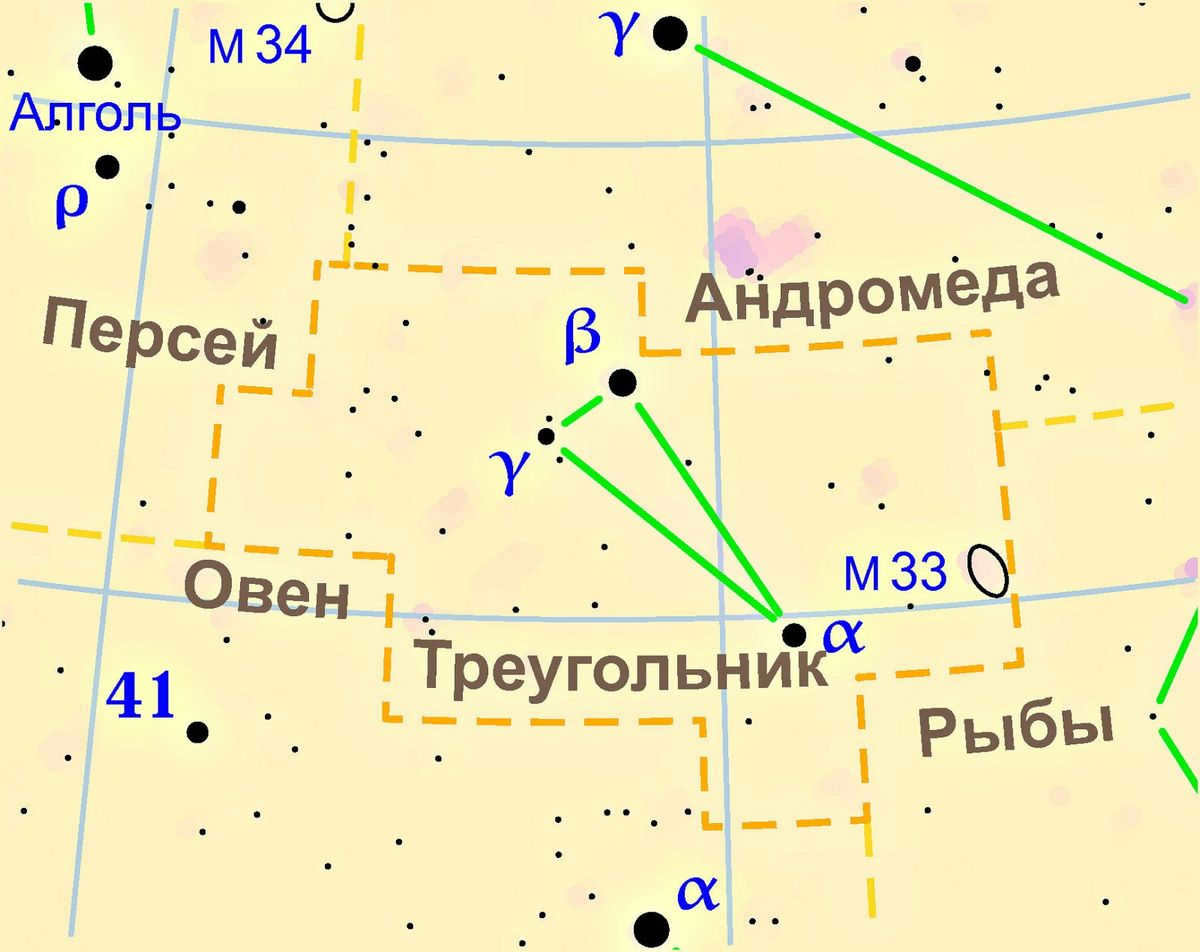
Around 54 globular clusters have been identified in M 33 by astronomers, but it is believed that there could be more than 122. These clusters are estimated to be several billion years younger than the ones found in our own galaxy. The formation of clusters has increased in the Triangle Galaxy over the past 100 million years due to the influx of gas into the central region of M 33.
The common catalog now includes separate entries for several star-forming regions found within the galaxy. One of the most famous of these regions is NGC 604, known for its active star formation. Additionally, there are other well-known H II regions in the galaxy, such as NGC 595, NGC 588, NGC 592, IC 132, IC 133, and IK 53.
M 33: The intriguing neighbor of the Milky Way
Have you ever had the chance to venture about 40 km outside of the city on a night without a moon? Does the weather permit you to marvel at the stars? If so, then I encourage you to seek out the neighboring galaxy of the Milky Way – the Triangle Galaxy (M 33) – which, as you may have guessed, resides just beyond the Triangle constellation. With the naked eye, it appears as a small, hazy cloud, but those who desire to study its structure will require a telescope with an aperture of 200 mm or greater and an eyepiece with a wide field of view. Anyone with keen eyesight can spot the Triangle Galaxy (or if you don’t possess sharp vision, you can search for it with the aid of glasses or contact lenses). It is advisable to refrain from using electronic devices for approximately 15-20 minutes before stargazing in order to allow your eyes to fully adjust to the darkness. By the way, the Triangle Galaxy is the farthest celestial object visible to the naked eye at night (excluding glasses and contact lenses). So, what exactly are we in pursuit of?
This particular spiral galaxy appears relatively diminutive in comparison to its counterparts. For instance, its diameter is two-fold smaller than that of the Milky Way, and its mass is about five to ten times less. With a diameter of merely 50,000 light-years, it pales in comparison to the expansive 100,000 light-year span of the Milky Way, the 220,000 light-year diameter of the Andromeda Galaxy, and the colossal 6 million light-year diameter of the largest galaxy observable in the Universe, IC 1101. Nevertheless, despite its seemingly modest dimensions, it still adheres to the average size typically observed in spiral galaxies.
The Triangle Galaxy, the Milky Way, and Andromeda form an inseparable “trinity” connected by the forces of gravity and dark matter. The Triangle Galaxy is in close proximity to us, approximately 2.7 million light-years away. It is highly probable that Italian astronomer Giovanni Battista Odierna discovered this galaxy prior to 1654. Odierna, a humble priest, dedicated his time not only to his ecclesiastical duties but also to scientific pursuits, with astronomy being his passion. Inspired by Galileo’s research, he constructed his own telescope and spent countless nights observing the night sky, meticulously documenting his findings. While he accurately described nebulae and galaxies, he mistakenly identified them as star clusters and made detailed sketches. Odierna’s notes also contain references to prominent celestial objects such as the Andromeda Galaxy, the Orion Nebula, and various star clusters. Subsequently, in 1764, the Triangle Galaxy was observed from Odierna’s location by Charles Messier, and later by William Herschel. Herschel, renowned for his discovery of Uranus, initially classified the Triangle Galaxy as a nebula. Although he was able to observe the spiral structure of Uranus, he noted that this “nebula” was densely populated with numerous stars.
If we observe the Triangle Galaxy, we perceive it as it existed 2.7 million years ago. Once again, in the grand scale of the Universe, this timeframe is relatively insignificant. What can we deduce about this particular galaxy? It harbors numerous youthful white and blue stars, and its spiraling arms contain copious amounts of interstellar gas and dust – the fundamental “building blocks” necessary for the genesis of fresh stars, making this galaxy the epitome of its prime state. For instance, within one of its spiral arms, there lies the NGC 604 emission nebula, spanning a width of 1300 light-years – the largest distinct zone of stellar formation, housing over 200 hypergiant stars! In total, scientists have identified 515 “stellar nurseries” – typical molecular hydrogen clouds that are compacted by gravitational forces, gradually replenishing the Triangle Galaxy’s arms with nascent stars.
The Hubble photo displays the NGC 604 nebula, which is renowned for being the largest stellar cradle.
Research has indicated that in ancient times, Andromeda and the Triangle Galaxy had some sort of connection: in 2004, scientists were able to observe a gas tail stretching from Little M 33 to Andromeda. Given the Triangle Galaxy’s distinct spiral shape, it is plausible to assume that it passed near Andromeda approximately 2 to 8 billion years ago, barely grazing its outer edge and resulting in the formation of the gas plume we see today, which serves as a reminder of their long-standing “acquaintance”. However, this was not their final encounter: the galaxies peacefully separated, assuming extreme positions in relation to the common center of mass of the entire Local Group. Nevertheless, they will reunite in approximately 1.5 – 2 billion years with renewed force, with the Triangle Galaxy merging into Andromeda. Eventually, the “heavier” Andromeda will merge with the Milky Way in approximately the same timeframe.
This is approximately how the Triangle Galaxy appears through a high-quality amateur telescope
The Triangle Galaxy may not be the most extraordinary entity in the Universe, and it can’t be compared to Andromeda and the Milky Way, but it is difficult to imagine our Local Group of galaxies without this small “star factory”. According to computer simulations, these galaxies will eventually merge in 4-5 billion years to form one massive elliptical galaxy, which has already been given the name Mlecomeda.
Computer model representing the merger of the Milky Way and Andromeda
Black holes typically reside in the cores of galaxies. They can be referred to as the “nucleus” of the galaxy, since despite their harsh nature, black holes play a vital role in the existence of these magnificent celestial objects: by absorbing matter, they emit a tremendous amount of energy necessary for the formation of new stars. It’s almost as if the Triangle Galaxy lacks a heart! Based on velocity measurements of stars using the Hubble Space Telescope, there is no evidence of a supermassive black hole at its core. Furthermore, M33 is a disk-shaped galaxy – unlike most spiral galaxies, it lacks a central bulge, although it does possess a luminous core. The absence of a black hole at the core and the lack of a central bulge in the galaxy are interconnected. However, it should be noted that even without a black hole at its “nucleus,” the galaxy is thriving! Or perhaps there is still something we don’t yet understand.
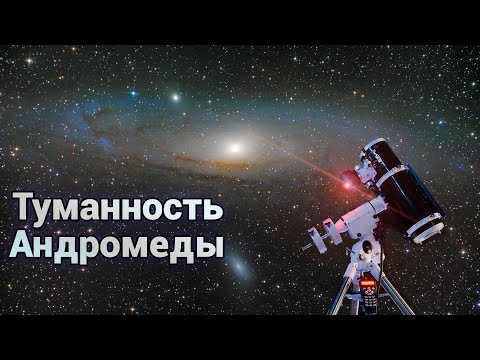
The Andromeda Galaxy, also referred to as Messier 31 or the “Great Spiral Galaxy,” is one of the farthest objects visible to the naked eye. Utilize the constellations surrounding the Andromeda Galaxy to ascertain its position in the celestial sphere. While it is faintly visible to the unaided eye, the use of binoculars or a telescope will enhance its clarity. For optimal viewing, venture outside on a dark night during the autumn or winter months. Initially locating the galaxy may prove challenging, but once found, it is difficult to lose sight of it once again.
Steps
Method 1 of 3: Finding the Andromeda Galaxy

Escape the bright lights of the urban area. The presence of artificial light can pose a challenge when trying to locate the Andromeda galaxy. It is advisable to distance yourself from the bustling city, its streetlights, and illuminated parks. Consider embarking on a hike up a hill, exploring a secluded meadow, or discovering a spot devoid of any light pollution.
Acclimate your vision to the absence of light. Unlike its neighboring stars, the Andromeda Galaxy does not emit a significant amount of brightness. When venturing out to observe the celestial bodies, allow yourself a quarter of an hour to attune your eyes to the darkness. You may perceive an increase in the number of stars visible to you compared to your initial impression.
Utilize a celestial map to determine the precise location of a galaxy in the celestial sphere. The positioning of galaxies, stars, and constellations may vary depending on the time of year. Locate the celestial map specifically designed for the current month.
- Oftentimes, free celestial maps can be found online. They may also be available for purchase at planetariums or astronomical societies.
- A celestial map can also provide information on the optimal time of day to observe the Andromeda galaxy, contingent upon the season.
- For instance, in September and October, the Andromeda Galaxy will ascend in the eastern sky of the northern hemisphere. By midnight, it should be positioned directly overhead.
- If you reside in the southern hemisphere, you can gaze towards the northern horizon in December to catch a glimpse. However, it will not reach a high point in the sky.
 Utilize a stargazing application. There are various applications accessible to assist you with locating the Andromeda Galaxy and other stars. These applications will adjust star charts based on your location, hemisphere, season, and time of night. Some recommended applications include Star Chart, NightSky, and GoSkyWatch.
Utilize a stargazing application. There are various applications accessible to assist you with locating the Andromeda Galaxy and other stars. These applications will adjust star charts based on your location, hemisphere, season, and time of night. Some recommended applications include Star Chart, NightSky, and GoSkyWatch.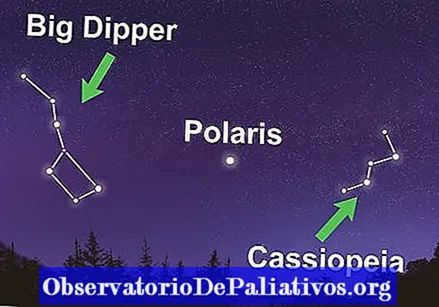 Locate the constellation Cassiopeia. In the event that you figure out how to find the Big Dipper, search for a brilliant star close to it called Polaris or Polaris. Across Polaris from the Big Dipper, you will discover Cassiopeia. Cassiopeia comprises of five “W” formed stars. The correct side of this letter W will point straightforwardly toward the Andromeda Galaxy.
Locate the constellation Cassiopeia. In the event that you figure out how to find the Big Dipper, search for a brilliant star close to it called Polaris or Polaris. Across Polaris from the Big Dipper, you will discover Cassiopeia. Cassiopeia comprises of five “W” formed stars. The correct side of this letter W will point straightforwardly toward the Andromeda Galaxy.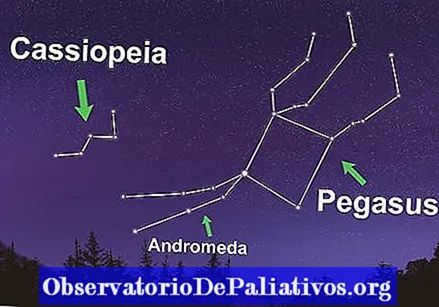 Discover the positions of the constellations Pegasus and Andromeda. Pegasus appears as a massive rectangle in the night sky. From the upper left corner of this star, you will notice two rows of stars. This represents the constellation Andromeda.
Discover the positions of the constellations Pegasus and Andromeda. Pegasus appears as a massive rectangle in the night sky. From the upper left corner of this star, you will notice two rows of stars. This represents the constellation Andromeda.- Remember that the constellation Andromeda is distinct from the Andromeda Galaxy.
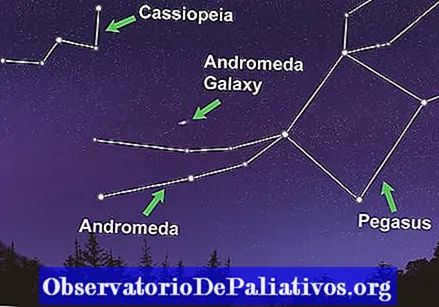 Locate the area between Pegasus and Cassiopeia. The Andromeda Galaxy can be found between the constellation Pegasus and the Cassiopeia region. In the sky, you will observe a blurry or hazy oval shape.
Locate the area between Pegasus and Cassiopeia. The Andromeda Galaxy can be found between the constellation Pegasus and the Cassiopeia region. In the sky, you will observe a blurry or hazy oval shape.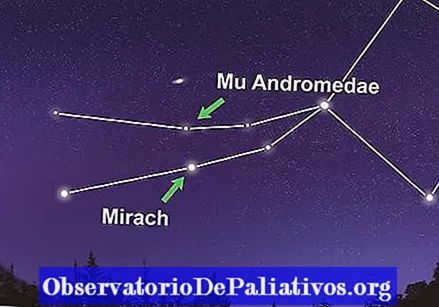 Trace a path across the night sky connecting the stars Mirach and Mu Andromeda. Commence at the star located in the upper left corner of the constellation Pegasus. This is the starting point of the Andromeda constellation. Proceed downwards along the Andromeda constellation, passing two stars. You will come across two stars, Mirach and Mu Andromeda, stacked one on top of the other. By drawing a line connecting these two stars and continuing past Mu Andromeda, you will arrive at the Andromeda galaxy.
Trace a path across the night sky connecting the stars Mirach and Mu Andromeda. Commence at the star located in the upper left corner of the constellation Pegasus. This is the starting point of the Andromeda constellation. Proceed downwards along the Andromeda constellation, passing two stars. You will come across two stars, Mirach and Mu Andromeda, stacked one on top of the other. By drawing a line connecting these two stars and continuing past Mu Andromeda, you will arrive at the Andromeda galaxy.- Mu Andromeda is fainter in brightness compared to Mirach. Additionally, it is the nearest star to the Andromeda galaxy.
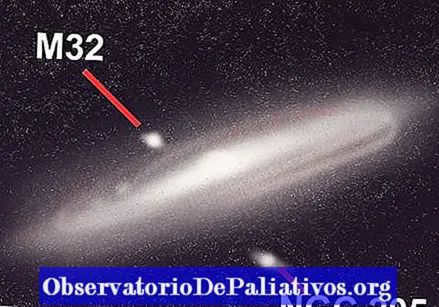 Search for accompanying galaxies. By utilizing a telescope, it is possible to locate two dim, hazy areas in close proximity to the galaxy. M32, one of these areas, is smaller in size and positioned nearer to the actual galaxy nucleus. Conversely, NGC 205 is larger and positioned at a greater distance from the real galaxy. Both of these areas are considered companion galaxies to Andromeda.
Search for accompanying galaxies. By utilizing a telescope, it is possible to locate two dim, hazy areas in close proximity to the galaxy. M32, one of these areas, is smaller in size and positioned nearer to the actual galaxy nucleus. Conversely, NGC 205 is larger and positioned at a greater distance from the real galaxy. Both of these areas are considered companion galaxies to Andromeda. Begin by locating the galaxy using only your naked eye. The Andromeda galaxy can be observed without the need for any special equipment. In the night sky, it will appear as a faint, blurry oval shape. Once you have identified the general area where the galaxy is situated, it will be easier to locate it using binoculars or a telescope.
Begin by locating the galaxy using only your naked eye. The Andromeda galaxy can be observed without the need for any special equipment. In the night sky, it will appear as a faint, blurry oval shape. Once you have identified the general area where the galaxy is situated, it will be easier to locate it using binoculars or a telescope. Opt for binoculars to get a closer view. Binoculars will allow you to get a more detailed look at the galaxy. After spotting the galaxy with your naked eye, gradually raise the binoculars and adjust the focus until you can see the galaxy. When viewed through the binoculars, it should resemble a cloud in the shape of an oval.
Opt for binoculars to get a closer view. Binoculars will allow you to get a more detailed look at the galaxy. After spotting the galaxy with your naked eye, gradually raise the binoculars and adjust the focus until you can see the galaxy. When viewed through the binoculars, it should resemble a cloud in the shape of an oval.- You can utilize regular binoculars for this task. The most optimal binoculars have lenses with 7×50, 8×40, or 10×50 specifications.
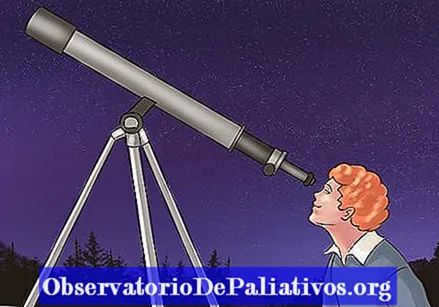 Opt for a telescopeto conduct a more in-depth examination. A typical telescope equipped with an 8-inch (20 cm) diameter reflector will enable you to observe the nucleus (or center) of the galaxy, as well as its two accompanying galaxies. The galaxy is so vast that it cannot be seen in its entirety at once through the telescope.
Opt for a telescopeto conduct a more in-depth examination. A typical telescope equipped with an 8-inch (20 cm) diameter reflector will enable you to observe the nucleus (or center) of the galaxy, as well as its two accompanying galaxies. The galaxy is so vast that it cannot be seen in its entirety at once through the telescope.- If you decide to use a telescope, set it to the lowest magnification. Despite the fact that the Andromeda Galaxy may appear relatively small to the naked eye, it will appear significantly larger when viewed through a telescope.
 Spot the Andromeda Galaxy during the autumn or winter months. For viewers in the northern hemisphere, the optimal time to catch a glimpse of the Andromeda Galaxy is between August and September. In the southern hemisphere, it can be observed from October to December. During these periods, the Andromeda Galaxy will become visible as soon as the sky begins to darken.
Spot the Andromeda Galaxy during the autumn or winter months. For viewers in the northern hemisphere, the optimal time to catch a glimpse of the Andromeda Galaxy is between August and September. In the southern hemisphere, it can be observed from October to December. During these periods, the Andromeda Galaxy will become visible as soon as the sky begins to darken.- In the northern hemisphere, the Andromeda Galaxy can be observed throughout the year; however, it may be more challenging to locate during other seasons.
 Opt for a moonless night. The presence of the moon can obstruct your view of the stars. To get the clearest glimpse of the Andromeda Galaxy, venture out during a new moon or crescent moon phase.
Opt for a moonless night. The presence of the moon can obstruct your view of the stars. To get the clearest glimpse of the Andromeda Galaxy, venture out during a new moon or crescent moon phase.- If the moon is at its full phase, locating the Andromeda Galaxy can prove to be challenging.
- A new moon occurs once every month. Utilize an online moon calendar to determine the ideal night for stargazing within that month.
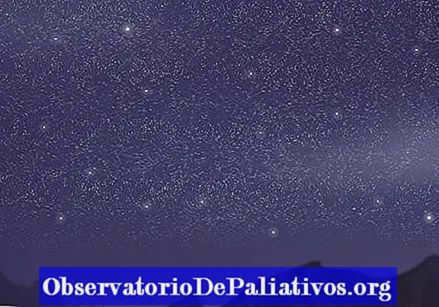 Check the weather for a cloud-free evening. Any presence of clouds in the sky will hinder your ability to see the stars. Before setting out, consult weather reports to ensure there will be no cloud cover.
Check the weather for a cloud-free evening. Any presence of clouds in the sky will hinder your ability to see the stars. Before setting out, consult weather reports to ensure there will be no cloud cover.
Method 2 of 3: Selecting instruments
Method 3 of 3: Enhance your perspective
Community Questions and Answers
Is it possible to observe it from Egypt?
Observing it from Egypt should be achievable, although it might be more convenient to view it in the northern regions of the country rather than in the southern parts.
Is it feasible to observe Andromeda from India?
What is the method for locating the Dumbbell nebula?
If I reside in the Northern Hemisphere, can I spot a galaxy during fall/winter?
Has anyone ever computed the real-time positions of celestial objects instead of their observed positions?
Why am I having trouble finding it? I use high-quality binoculars and search in the exact spot. I can see every faint star except for the galaxy itself.
Alright. Can I observe Andromeda and the Milky Way in Peru?
What methods can be used to locate Canavis Majoris in the nighttime sky?
I am interested in obtaining precise information on the angular direction, such as 35 degrees north of east, north of west, etc., as well as the angle of elevation. What steps can I take to achieve this?
When the sky is devoid of many stars, is it more difficult to locate or easier to observe the Andromeda Galaxy?

